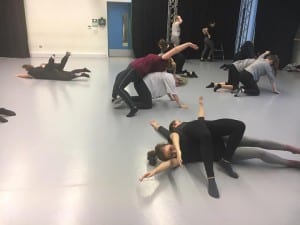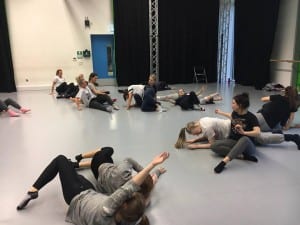Exploring new anchor points was useful to the whole class – however focusing on the front of the body now distracts us from all our knowledge on rolling onto the back/ other parts of the body. Working with new frames and new anchor points made it hard for me to balance on a body, as I am not used to working with these movements. It was difficult to listen to bodies whilst exploring follow-on movements – only suitable whilst moving at a slow pace to keep the connection between bodies. Moving at a slow pace is in my comfort zone which I tend to stick with.
Observing the 4-man jam was inspiring to watch and to identify new movement material from my peers. Slow-going movements establish on-going connections and explorations which I needed to work on myself. Keefe states “Just think of the endless variety of ways in which the dancers may move.” (232, 2003). New movement feels fantastic if carried-out correctly – nevertheless, because there are many variations of movement, I find it uneasy listening to my partner and accept that I will not be prepared for some actions. Still, this task opened my eyes to see how a jam is supposed to run.
Focusing on the weight and alignment of the pelvis seemed smooth as a soloist, exploring the lower kinesphere in depth. However, I found this image of the pelvis to wonder whilst dancing in duets and focus on the new material we have learnt. Next week I am determined to attempt more trios to challenge myself and experience different bodies in the space.
Keefe, M. (2003) What’s the score? Improvisation in everyday life. Middletown, Connecticut: Wesleyan University Press.


![IMG_3921[1]](https://laurenfretwellcontact.blogs.lincoln.ac.uk/files/2016/11/IMG_39211-300x225.jpg)